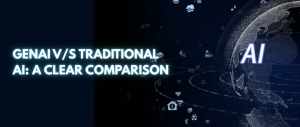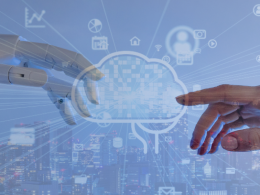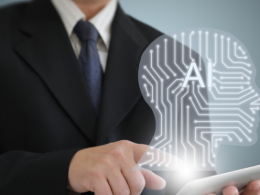Generative AI (GenAI) has exploded into the mainstream — writing copy, generating art, coding apps, and even powering customer service agents. But to really understand its role, we have to compare it to the foundation it evolved from: Traditional AI.
If you’re a founder, marketer, product builder, or just AI-curious, this breakdown will give you the strategic edge in knowing when (and how) to use each type of AI — and where they overlap.

⚖️ GenAI vs. Traditional AI — At a Glance
| Feature | Traditional AI | Generative AI (GenAI) |
|---|---|---|
| Primary Function | Analyze, predict, classify | Generate new content (text, image, etc) |
| Data Use | Learns from structured data | Learns from unstructured data |
| Output Type | Labels, scores, decisions | Images, text, code, audio |
| Use Cases | Fraud detection, recommendations | Chatbots, content creation, design |
| Examples | Decision trees, regression models | GPT-4, DALL·E, Midjourney |
🧠 What Is Traditional AI?
Traditional AI refers to rule-based systems and machine learning models that are trained to analyze data, recognize patterns, and make decisions. These systems are designed for specific, predictable tasks and excel in environments with structured inputs and clear outputs.
Characteristics:
-
Deterministic outputs: Same input produces the same output every time.
-
Rule-driven models: Often use decision trees, random forests, logistic regression, or neural networks.
-
Supervised learning: Requires labeled datasets to train effectively.
Examples:
-
Credit scoring systems
-
Medical diagnosis from structured inputs
-
Product recommendation engines
-
Spam email detection
In short, traditional AI is about efficiency, accuracy, and control.
🎨 What Is Generative AI (GenAI)?
Generative AI represents the next phase of AI — systems that can learn complex patterns in massive datasets and generate original content, including natural language, imagery, video, audio, and even code.
Instead of classifying or predicting, GenAI models like GPT, Claude, or Stable Diffusion create based on probabilistic patterns learned during training.
Characteristics:
-
Probabilistic outputs: Same input might generate different results.
-
Unstructured learning: Trains on large, messy datasets (e.g., internet-scale text, images, videos).
-
Foundation models: General-purpose models that can be fine-tuned for specific tasks.
Examples:
-
Writing entire blog posts with GPT-4
-
Generating user interface designs from wireframes
-
Producing synthetic voiceovers for videos
-
Creating personalized marketing emails
Where traditional AI analyzes, GenAI creates.
🔍 Deep Dive: 5 Core Differences
1. Output Purpose
-
Traditional AI is predictive — used to automate decisions or classifications.
-
GenAI is generative — it synthesizes new content that didn’t exist before.
Think of traditional AI like a filter. GenAI is like a canvas and brush.
2. Data Dependency
-
Traditional AI needs structured, labeled data (e.g., spreadsheets, sensors, transaction logs).
-
GenAI learns from unstructured data like books, audio recordings, or images scraped from the web.
This distinction means GenAI can function in more ambiguous, creative environments.
3. Model Complexity
-
Traditional AI models are often narrow and task-specific.
-
GenAI models are typically multi-purpose, large-scale architectures capable of transfer learning.
Foundation models like GPT-4 are pre-trained on general data and then fine-tuned for niche tasks — allowing businesses to iterate faster and cheaper.
4. Interpretability
-
Traditional AI often favors explainability (especially in regulated industries).
-
GenAI can be more of a black box, generating outputs that aren’t always easy to trace back to input logic.
This tradeoff matters depending on your industry — for example, banking may lean toward traditional AI, while marketing thrives with GenAI.
5. Use Case Fit
| If you need… | Use… |
|---|---|
| High-accuracy forecasting from clean data | Traditional AI |
| Dynamic copy or creative content | Generative AI |
| Automation of structured tasks | Traditional AI |
| Personalization at scale | Generative AI |
| Regulatory transparency | Traditional AI |
| Exploratory content generation | Generative AI |
🛠 Real-World Example: E-Commerce
Let’s say you’re running an online fashion store:
-
Traditional AI can analyze user behavior to predict which products someone might buy.
-
GenAI can then use that data to generate personalized product descriptions, headlines, or emails to nudge conversion.
Combined, the two create an end-to-end AI pipeline: insight → content → engagement.
⚙️ How They Work Together
Many modern AI systems blend both approaches:
-
Chatbots: Use traditional AI for user intent classification, GenAI for dynamic responses.
-
Ad optimization: Traditional AI allocates budget based on performance data, GenAI generates creative variants for testing.
-
Customer support: Traditional AI routes tickets; GenAI drafts helpful replies instantly.
You don’t have to choose one — the best AI stacks integrate both.
🔮 Future Outlook
Generative AI will likely dominate customer-facing experiences: sales, marketing, content, UX. Traditional AI will continue to power backend systems: risk models, inventory, finance.
As the field matures, we’ll also see more hybrid AI models, where GenAI output is checked or refined by traditional models for compliance, accuracy, or ethical alignment.
📈 Bonus: SEO Tips to Rank for “GenAI vs. Traditional AI”
Want to capture the featured snippet on Google for this term? Here’s how to optimize:
-
Use a direct comparison table early in the post
-
Include “What’s the difference?” phrasing in your H2 or body text
-
Write a 40–50 word summary answer directly after your intro
-
Use clean, structured formatting (H2s, bullets, bolded keywords)
-
Add schema markup (FAQ, Article) to improve snippet eligibility
✅ Final Takeaway
Generative AI expands the boundaries of what’s possible. While traditional AI is reliable, focused, and rules-based, GenAI opens up endless possibilities for content, personalization, and customer experience. The real power? Knowing when to use each — and how to combine them.
If Traditional AI is your engine, GenAI is your turbocharger.
Ready to Dive Deeper into the World of AI?
If this blog has sparked your interest and you’re eager to build a career in this high-impact field, now’s the time to take the next step! Check out our E&ICT Academy IIT Guwahati Executive Program in Leadership with AI to gain in-depth knowledge, hands-on experience, and industry-relevant skills.
Whether you’re a professional looking to upskill or a beginner aiming to break into the industry, this program is designed to equip you with the expertise needed to thrive in the competitive world of AI. Enroll today and start your journey toward becoming an AI powerhouse!






